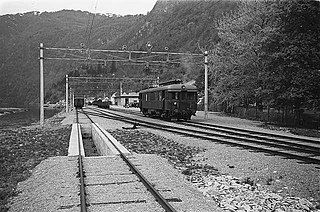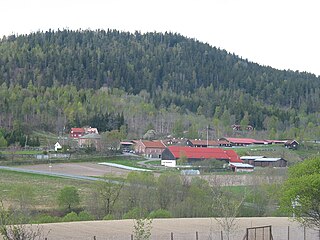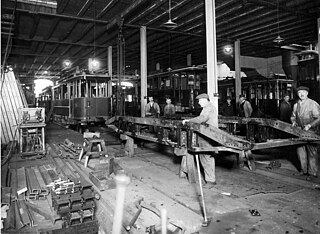Related Research Articles

The Røa Line is a rapid transit line of the Oslo Metro, Norway, which runs from Majorstuen in Oslo to Østerås in Bærum. It serves neighborhoods such as Smestad, Hovseter, Huseby and Røa in northwestern Oslo, and Grini, Øvrevoll and Østerås in northeastern Bærum. The line is served by Line 2 of the metro, which connects to the city center via the Common Tunnel and onwards along the Furuset Line. The lowest part of the Røa Line, consisting of two stations, is shared with the Kolsås Line, and thus also served by Line 2 of the metro. The Røa Line is owned by Kollektivtransportproduksjon, and operated by Oslo T-banedrift on contract with the public transport agency Ruter.

Østhorn is a station on the Sognsvann Line of the Oslo Metro in Norway. It is located 7.1 kilometres (4.4 mi) from Stortinget station between Tåsen and Holstein stations. As one of the original stations on the line, Østhorn was opened on 10 October 1934. Nordberg was formerly the next northbound station, but it was closed in 1992, when the Sognsvann Line was upgraded to metro standard. Østhorn is located near a hill named Havnabakken, where local residents toboggan during winter time.

NSB Class 64 is a class of three electric multiple units built by Strømmens Værksted for the Norwegian State Railways. Delivered in 1935, they were built for the opening of the Hardanger Line and served there until 1985, when the line closed and the trains were retired. They also periodically served on the Flåm Line. The delivery consisted of three motor cars and four carriages, with each train consisting of up to three units. The motor cars were 16.3 meters (53 ft) long, had a power output of 464 kilowatts (622 hp) and were capable of 50 km/h (31 mph). The motor units were given road numbers 505 through 507. Two of the units have been preserved by the Norwegian Railway Club and are at Garnes Station.
Skabo Jernbanevognfabrikk was a mechanical workshop focusing on design and construction of railcars. It was established by Hans Skabo in Drammen, Norway, in 1864; it became the first rail car factory in the country when it took delivery of the cars for Kongsvingerbanen. Due to the size of the venture, it moved to Tyskerstranden at Skøyen in Kristiania in 1873.
Timeline of transport in Oslo covers key incidents within transport in Oslo, the capital of Norway.

Holtet is a light rail/tram stop on the Ekeberg line of the Oslo Tramway. It is located at Holtet in Ekeberg, in the borough of Nordstrand, in Oslo, Norway.

Øverland is an area in Bærum, Norway. Named after the local farm, Øverland is also known as a recreational area and for its arboretum. It has lent its name to the river Øverlandselva.

Private railways in Norway consist of industrial and public railways. Industrial railways were used to transport ore or other industrial products to ports, although they have, particularly to begin with, also operated passenger and cargo services. The other nine private railways have been public and operated as mixed passenger and freight services. Of these, four were later taken over by the Norwegian State Railways (NSB). Only five non-industrial railways were never nationalized, despite all having been closed. There were the Nesttun–Os, Holmestrand–Vittingfoss, Lillesand–Flaksvand, Tønsberg–Eidsfoss and the Lier lines. No industrial railways remain in operation, although one former private railway, the Trunk Line, Norway's first railway, is still in use.

Skillebekk is a neighbourhood of Oslo, Norway. It is located near Solli plass in the West End of Oslo, and is served by the station Skillebekk on the Skøyen Line. The name origins from Skillebekken, a brook between Bymarken and Frogner Hovedgård.

Homansbyen Depot, officially Kristiania Sporveisanlæg was an Oslo Tramway depot located at Sporveisgata 8 near Bislett in Oslo, Norway. It was constructed for Kristiania Sporveisselskab in 1874 and was the first tramway depot in the country. The facilities were designed by Henrik Thrap-Meyer and featured an administrative office, a horse stable, a forge, a workshop, a weighing shed, and a wagon depot. It had space for 28 horse wagons, 16 sleds, and 116 horses. The administrative office was built in brick and housed apartments, offices, and a laboratory for the veterinarian. The depot was reconstructed several times, and taken out of use in 1966. It was demolished three years later, and replaced with residential apartment blocks.
Rodeløkka Depot was a tram depot located in Verksgaten at Rodeløkka in Oslo, Norway.

Per Kure was an electrical engineer and businessman. He was the founder of the firm A/S Per Kure.
Skotfoss Bruk was a paper mill located in Skotfoss, Skien, Norway. The mill was part of the Union Co., founded in 1890. It closed production on 31 December 1986.
References
- ↑ "Tregere enn for 50 år siden". Verdens Gang (in Norwegian). 25 August 2003.
- ↑ Store Norske Leksikon. "Nils Carl Aspenberg".